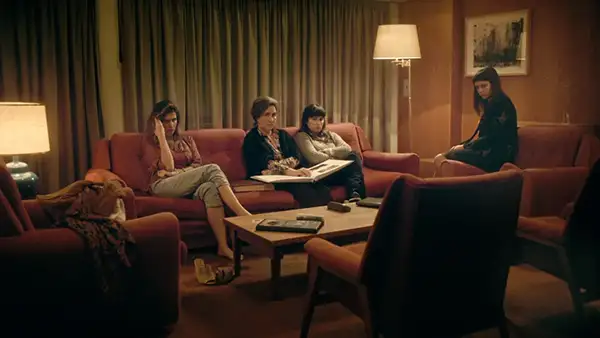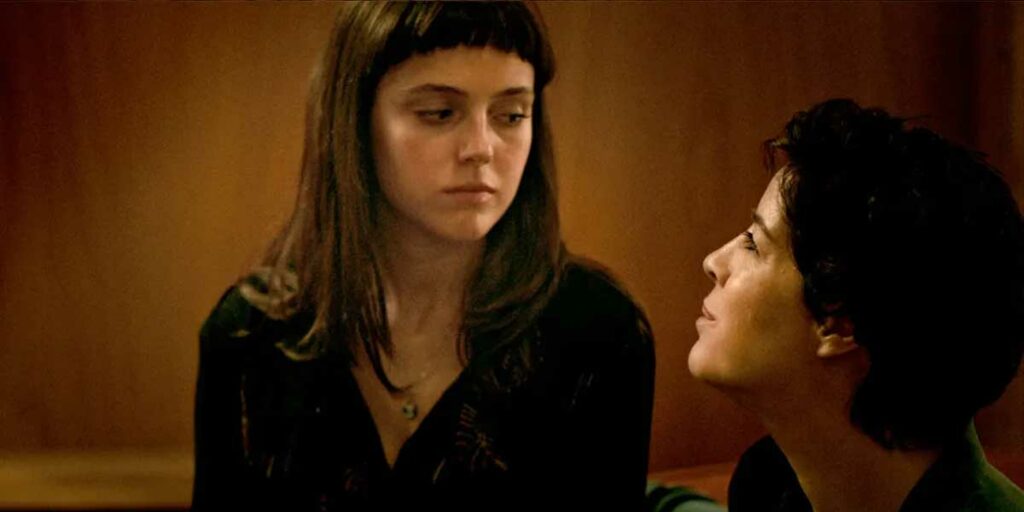Bad Living is a bleak family portrait framed in loneliness and despair, where a family of women find themselves in complete isolation yet constantly drawn to each other’s misery in the vast hotel they run.
On paper, a discussion about Bad Living (Mal Viver) should be much more fruitful after watching its sister film, Living Bad. The fact both movies were conceived together, share the same cast and crew, and are set in the same single location — a minimalistic, somewhat luxurious hotel — seems to indicate that Bad Living and Living Bad complement each other, let alone the way the movie titles mirror one another. There’s a clear reason why both movies have so many things in common, I assume, but likewise, there’s a reason why Portuguese director João Canijo decided to separate them into two movies, and I’ll stick to this line of thought. I have decided then, to write about Living Bad without watching its second, so to say, “volume”, and I’d start by saying the rawness and audacity of the film left me nothing but mesmerized from beginning to end.
Bad Living follows the lives of the women who take care of a traditional family hotel (the other movie, Living Bad, follows the hotel’s guests). Salomé (Madalena Almeida), the youngest of all, is mourning her recently deceased father and is brought by her grandmother Sara (Rita Branco) to their hotel, where Salomé’s estranged and mentally unstable mother Piedade (Anabela Moreira) lives while taking care of the place.
The movie opens with a scene shot from afar; the hotel’s pool extends fully across the screen. The figures that wander there are barely perceptible. Guests approach. In a cold, awkward embrace, mother and daughter reunite in tragic circumstances. The opening scene is the first hint at Leonor Teler’s piercing cinematography. It sets up right away the unutterable distance between these characters even though they share the same roof. Teler’s lens gives texture to thoughts and expressions, exposing what’s left unsaid in the images; an important trademark given Bad Living’s slow, melancholic pace.
In one instance, a dinner scene is shot dangerously close to each character’s face in unsettling angles, alternating as the film cuts from one side of the table to the other. The weird angles look like bad omens summoning the heated argument about to commence, in which the characters spit out the worst of themselves. As silence ensues, the film cuts to a wide-angle that reveals the vastness of the dining saloon they find themselves; an empty, dimly-lit chamber filled with tables and chairs, reserved for the tormented souls of a hopeless family; a clear sign of how these characters are trapped to themselves and their rotting roots.

The vastness of Bad Living’s single location, the hotel, is crucial to the narrative. There, the characters haunt the rooms and corridors in search of conversations to overhear or a safe haven from their despair. Simultaneously, there’s an atmosphere of isolation that envelops each and every one of the main characters, despite being surrounded by a variety of people and space. The movie’s biggest themes are the decay of family ties and lack of communication, addressed by João Canijo with subtle brutality. Bad Living is filled with psychological violence: you have three generations of women whose incapability of love leads to irreparable damage that affects everyone around them.
Canijo lays out two possible truths, both equally unfathomable to digest: some people will never learn how to love, and some parents just don’t love their children. It’s up to the viewers to reach a conclusion whether it is one or the other, but both bleak conclusions make perfect sense in the film’s cruel, perpetually melancholic approach. Bad Living’s hopeless tone gives little to no space for a solution; from beginning to end these women seem stuck in limbo, and only a great tragedy can take them out of that stupor. By the film’s third act, I was already feeling somewhat exhausted; I knew exactly what would happen, for there was not much surprise around it, however, an already slow pace happened to get increasingly slower, and the long, silent shots were beginning to frustrate me. Hopefully, the final scene makes up for all the waiting.
The title Bad Living, beyond its unsubtly literal meaning, evokes yet another interesting definition when taking the original “Mal Viver” into account. In Portuguese, such an expression could as well mean something like “barely living”, which only hits harder when one begins to chew on the movie. It reminded me of another harrowing family drama; Michael Haneke’s The Seventh Continent, which recounts the true-story of an Austrian family — husband, wife, and a daughter — who grow increasingly frustrated with modern life, to the point they decide to take their own lives. Indeed, there’s a lot of Haneke’s cinema in Canijo’s chilling family tale. Much like Haneke’s best films, it feels as if Death is lurking in the shadows of the film’s hotel; less in the form of Salomé’s recently deceased father but rather in the shape of living ghosts; beings whose souls are so worn-out that they’re no longer humans, they are already gone.
That’s how I see the cruel, somber characters of Bad Living. They are sordid people stuck in a vicious cycle that has been going on for too long. They refuse to move on, find medical help, or effectively communicate; when they engage in a dialogue, it feels as if they’re talking to themselves rather than with the person in front of them. Finally, the hotel stands as a clear representation of their ruin. Despite overstaying its welcome by a slight margin, the movie excels as a bleak family portrait framed in loneliness and despair, making me eager to revisit these characters and their guests in Living Bad.
Bad Living (Mal Viver) was screened at the Festival do Rio on October 12-18, 2023.

